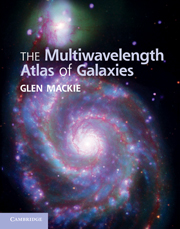Book contents
- Frontmatter
- Contents
- Preface
- Acknowledgements
- 1 Galaxies
- 2 Observing the electromagnetic spectrum
- 3 A view from the inside: The Galaxy
- 4 The Atlas, pages 67 to 153
- The Atlas, pages 153 to 218
- Appendices and references
- General text references
- Major image sources and references
- Selected references by galaxy
- Acknowledgements and permissions
- Galaxy index
- Index
2 - Observing the electromagnetic spectrum
Published online by Cambridge University Press: 05 June 2012
- Frontmatter
- Contents
- Preface
- Acknowledgements
- 1 Galaxies
- 2 Observing the electromagnetic spectrum
- 3 A view from the inside: The Galaxy
- 4 The Atlas, pages 67 to 153
- The Atlas, pages 153 to 218
- Appendices and references
- General text references
- Major image sources and references
- Selected references by galaxy
- Acknowledgements and permissions
- Galaxy index
- Index
Summary
Earth's atmosphere and extraneous radiation
Not all photons emitted by astronomical objects are detected by ground-based telescopes. A major barrier to the photons path is the Earth's ionosphere and upper atmosphere that absorbs or scatters most incoming radiation except for the optical (wavelengths of 3300–8000 Å where 1 Å = 10-10 m), parts of the near-IR (0.8–7 μm) and radio (greater than 1 mm) regions. Absorption greatly affects radiation with the shortest wavelengths. In general, gamma rays are absorbed by atomic nuclei, X-rays by individual atoms and UV radiation by molecules. Incoming IR and submillimeter radiation are strongly absorbed by molecules in the upper atmosphere (e.g. H2O and carbon monoxide, CO). Observations in these regions greatly benefit by locating telescopes at high altitude. Mountain-top sites like Mauna Kea (altitude 4200 m) in Hawaii, Cerro Pachon (2700 m), Las Campanas (2500 m) and Paranal (2600 m) in Chile, and La Palma (2300 m) in the Canary Islands are used to decrease the blocking effect of the atmosphere. The Antarctic, in particular the South Pole, provides an atmosphere with low water vapor content. Most of the continent is at high altitude, with the South Pole 2835 m above sea level, again helping to reduce the amount of obscuring atmosphere. The Antarctic has therefore also become a very useful IR and submillimeter site.
The transmission properties of the Earth's atmosphere (Figure 2.1) has prompted the exploration of the gamma ray, X-ray, UV, mid- and far-IR regions of the electromagnetic spectrum via satellite and high-altitude balloon observations.
- Type
- Chapter
- Information
- The Multiwavelength Atlas of Galaxies , pp. 29 - 54Publisher: Cambridge University PressPrint publication year: 2011



